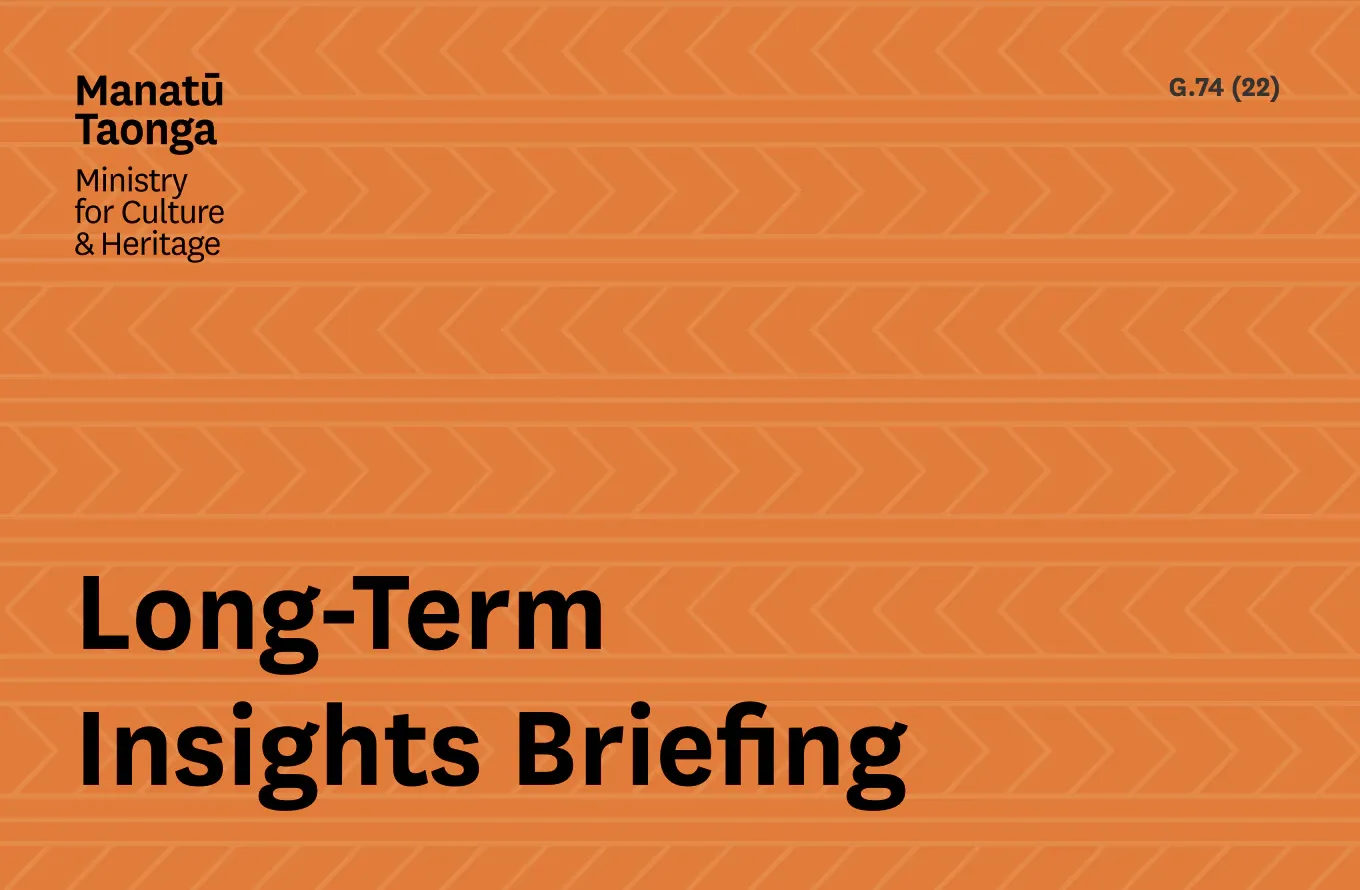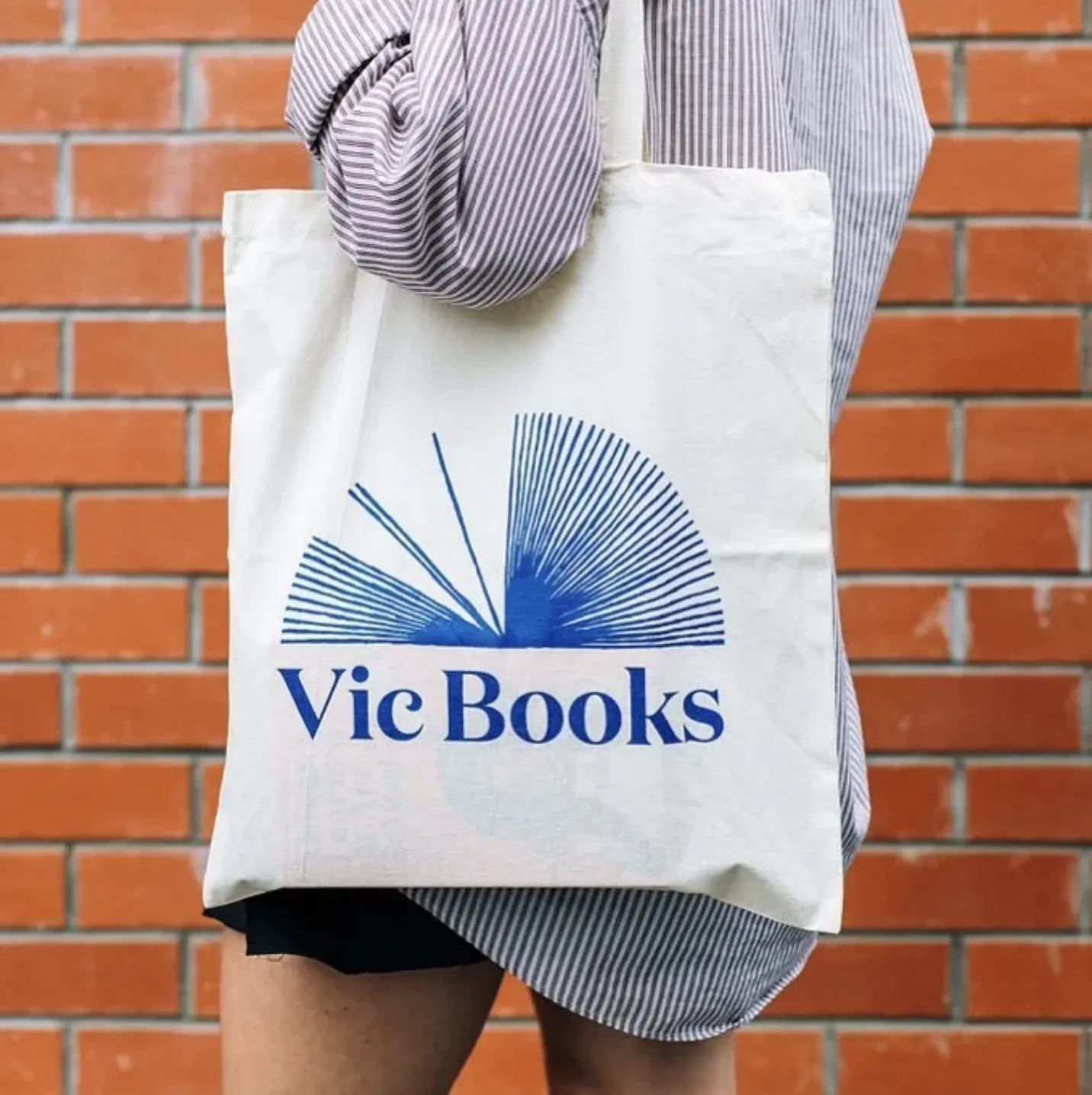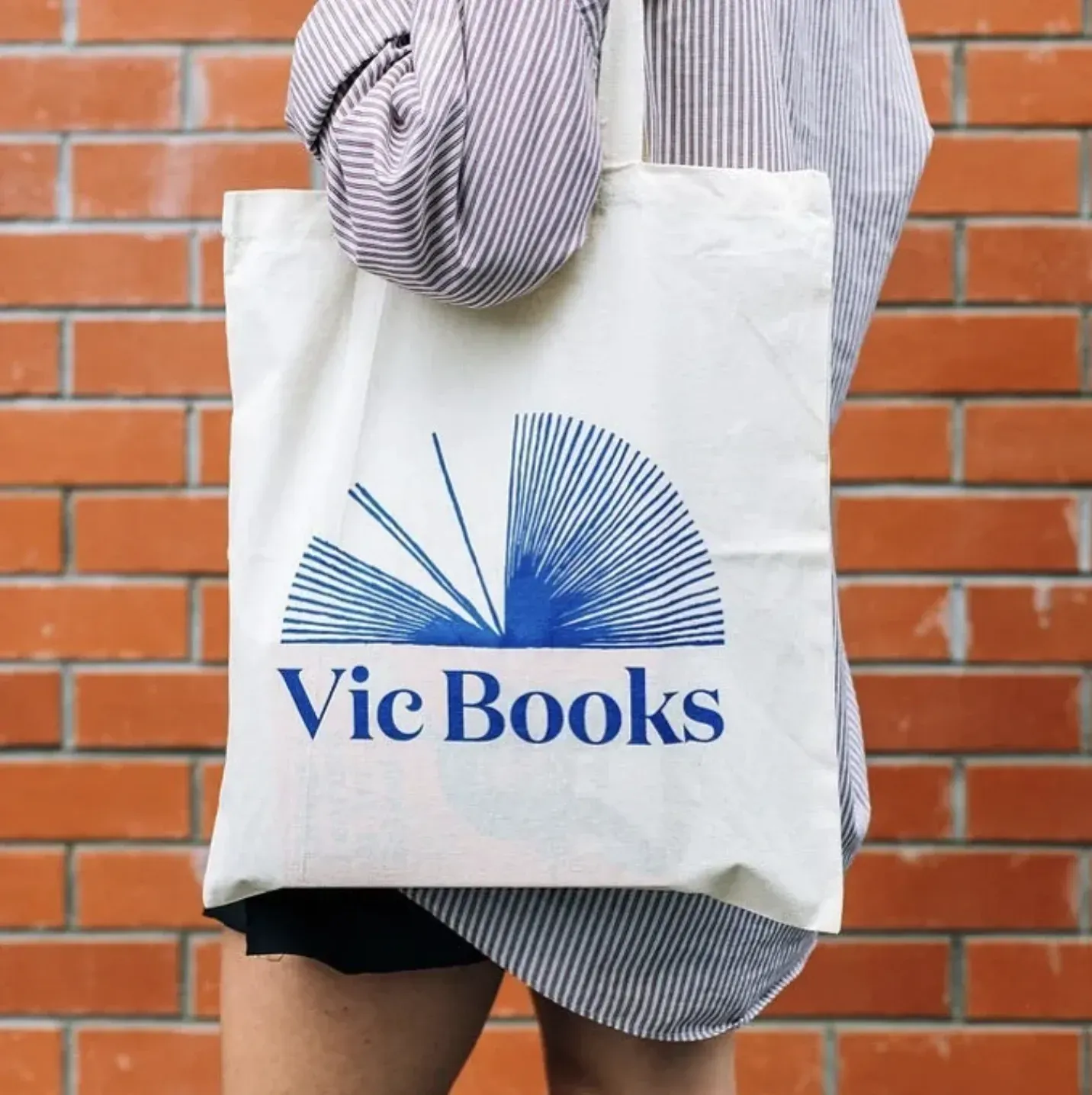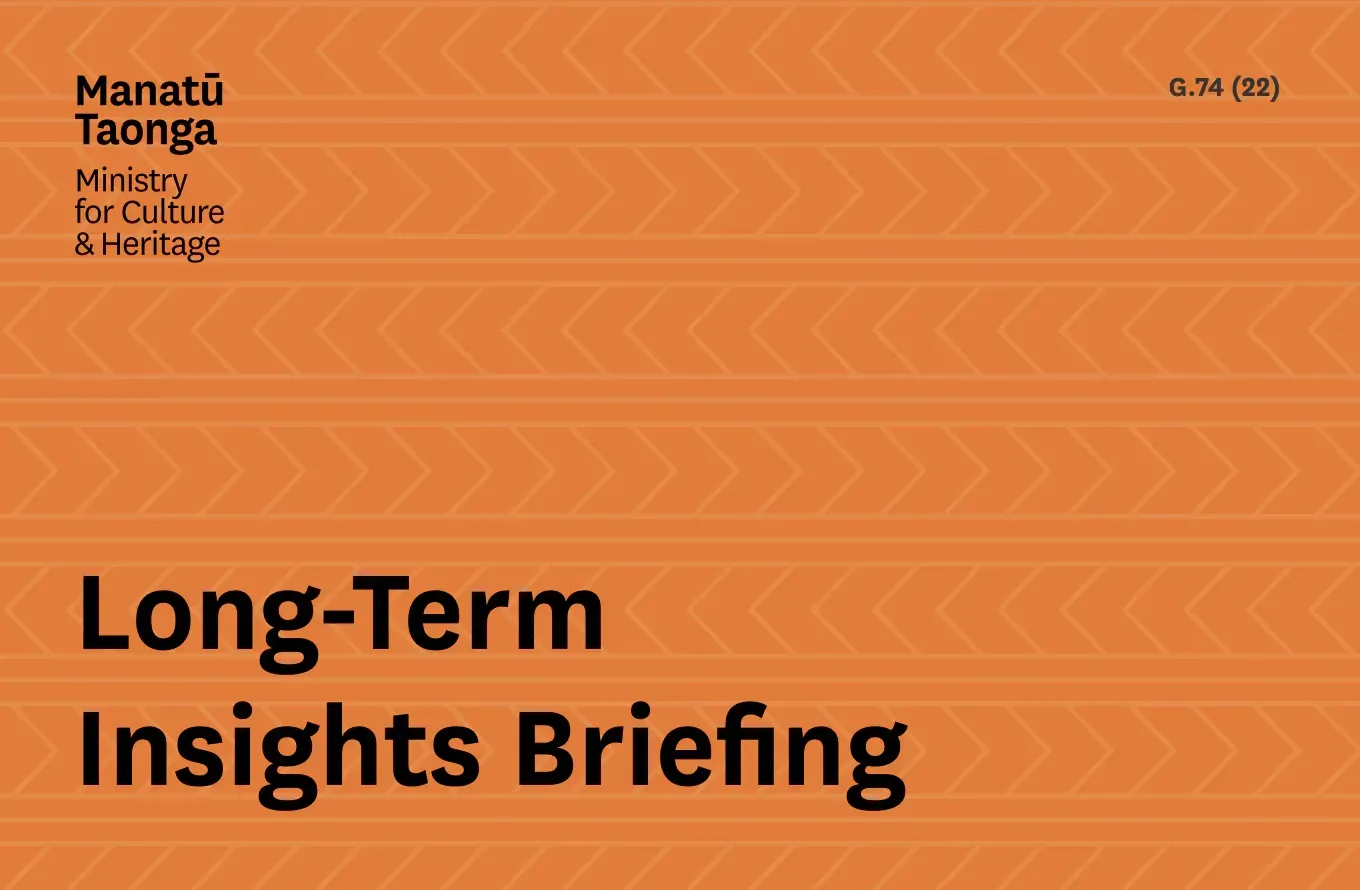Lowdown: Big Picture Focus, Immediate Arts Urgency
Written by

2023 is a year where big decisions have to be made when it comes to the support and funding leadership of the creative sector.
The COVID recovery money will officially all be dished out in the coming months, many from regional grass roots to leading arts organisations are standing at a crossroads of how they can carry on and there’s an election coming that could have a monumental effect on the creative community.
To find answers, you need to ask questions. And the first big information drop of 2023 comes from Manatū Taonga Ministry of Culture and Heritage (MCH), who has released the findings of its Long-Term Insights Briefing (LTIB).
Does the name ring a bell? That’s because it’s been in the planning and discussion since early 2021, with two rounds of engagement involving over 150 individuals and organisations with an interest or experience in the sector before being tabled in December last year - it has only finally been published online now.
At 37 pages deep, it’s an extensive read and one that will offer differing areas of priority to different creatives - you can find it here.
It covers topics you’d expect any Government agency to seek answers for in these post pandemic days - well-worn phrases like ‘sustainable’ and ‘resilient’ featured regularly in the multi-year process.
MCH is clear in stating the Briefing is a think piece on the future, not government policy - made “to identify and explore the issues that matter for the future wellbeing of the people of New Zealand”, as well as “provide an opportunity to enhance public debate on long-term issues and usefully contribute to future decision making.”
Cutting to the chase, the five priorities for the sector that emerged as the focus for this briefing are: Te Ao Māori; funding, investment and value; population change; digital technologies; and climate change.
The stats
It’s always interesting to see what economic statistics are being used behind these discussions - and here are some of the highlights pointed out in this MCH briefing.
• The arts and creative sector represents about 3.3% of New Zealand’s economy and this contribution has grown by about one-third since 2000
• In the year to March 2021, the sector generated $10.851 billion
• Between 2000 and 2021, the economic contribution of the arts and creative sector more than doubled (+121%) in real terms, outstripping the economy as a whole (+70%)
• The boundaries of the sector are hard to define, but using Stats NZ Employment Classifications, there were 94,689 arts and creative sector jobs as at March 2021
• There were 30,986 arts and creative businesses in New Zealand in March 2021, mostly clustered in the main centres: 44.3% in Auckland and 25.7% in Wellington and Canterbury combined.
• There is a very high rate of self-employment in the creative professions: 35.9% versus 16.7% in the New Zealand workforce.
• Attaining career sustainability and reward is challenging for many creative professionals. The research A Profile of Creative Professionals 2019 found considerable variation in career sustainability by artform, and 55% of all creative professionals did paid work outside of the creative sector.

The $10 billion figure is a useful one to throw at any potential investors into your creative practice - while numbers like the high rate of self-employment should hopefully encourage the Government to extend its current Creative Careers pilots into longer term support.
Funding
All of the focus areas carry importance, but it’s likely one will have more immediate focus to the creative community than others.
The biggest bone of contention in 2022 (and let’s face it, years before that) was the demand vastly exceeding the supply of creative funding available. It’s become a constant pressure point and has forced too many creatives out of the sector.
The first taste of engagement underlined what many would already know - but it’s useful to be aware of what is on the radar of decision makers.
The feedback received didn’t pull any punches, as you would expect.
The briefing outlines “participants questioned the role of government and Manatū Taonga in the sector, and suggested that the current funding/investment system is too slow, too ‘old school’, and too inflexible to keep up with change and innovation.
“Government institutions were seen as overly bureaucratic, acting as gatekeepers but moving too slowly in making funding decisions. Participants also noted a lack of joined-up thinking from central and local government, with different agencies operating under different mandates.
“Participants agreed that the current systems for funding do not work for everyone, that certain groups fall through the cracks, and that better representation and consideration of diverse worldviews are needed.
“The funding system was also described as ‘fragmented’ and ‘breeding competition’, which was seen as detrimental to collaboration.”
Some scathing words - but on the money, if you pardon the pun.
As a result, the briefing states “further investment is needed, and Manatū Taonga needs to consider what that investment could look like. For example, investments in technology are needed to keep up with digital changes. Focusing on collaboration and leadership could help with the financial resilience of the sector. A key question is what role central and local government should play in funding the sector.”

Emily Fabling, MCH’s Deputy Chief Executive, Policy and Sector Performance (above), told The Lowdown “we’ve worked hard to make sure the sector survives by investing nearly half a billion dollars to support creatives and professionals. This has shifted to making sure the sector is equipped to thrive by using the remaining funding in the Regeneration Fund to focus on finding and funding projects that have a lasting difference for the sector.
“Longer-term Ministry projects are underway to support the financial viability of creatives and the sector. As you’ve reported on The Big Idea, we’re working to establish an Artist Resale Royalty Scheme which will ensure the creators of visual arts are recognised and rewarded when their work is resold on the secondary art market.
“The briefing outlines a number of opportunities available to Manatū Taonga in this space, for example considering innovative ways of rapidly delivering funding where it’s needed, and continuing to design funding and investment strategies that support regional and local arts, culture and heritage.”
Ecosystem and attitude
Wellbeing is another regularly used buzzword in the report - it’s hard to imagine any such conversation piece not including it from here on in.
That’s including some questions and reflection on how members of the creative community are treated or better understood during these processes.
The frustration of different hoops to jump through and priorities from bodies like MCH to Creative New Zealand and others is well highlighted.
Some participants "expressed concern about a lack of understanding of how the different parts of the sector interrelate with each other. There was also a view that an ‘ecology’ or ‘ecosystem’ approach is at odds with the current competitive funding methods, although no alternative to competition was suggested.
“There was a widespread call for the development of a cohesive sector strategy or policy – with the proviso that any such policy should not be setting directions or trying to drive the sector.
“Feedback suggested a unified strategy could deliver greater wellbeing both within the sector, and to Aotearoa by connecting the sector better within itself, and with central and local government to influence policy especially in relation to the economic aspects of wellbeing.”
When asked how the labelled ‘people-first approach’ will influence decisions from Manatū Taonga, Fabling expands “we’ve seen first-hand through the various initiatives rolled out through the Arts and Culture COVID Recovery Programme that regularly seeking feedback on what we do leads to better outcomes and that’s something we’re keen to see continue developing.
“A people-first approach was top of mind when we were designing the Regeneration Fund, for example. Making sure that applicants had a relationship manager they could ask questions and help them through the process, rather than an anonymous email inbox.
She says that MCH will be sharing the lessons learned during this process in their next COVID Response Impacts Report. “We hope that other arts funders in the sector can learn from our mistakes.”
What happens next
Information and opportunities for change like this are certainly useful - but not as useful as action.
Many in the creative community have bemoaned the number of reports, think-tanks and committees that have talked the talk but nothing changes. It’s a fair critique.
Where this briefing leads is still up in the air.
With the report now out in public, MCH says the plan is to further discuss these priorities with those they affect, before the LTIB will be considered by the select committee later this year.
Fabling explains “we are now starting to think about ‘implementation’ – how we begin to collaborate with the cultural sector to start making sure we are on the pathways identified in the briefing – we’ll share more about this in the near future.
“Our hope is that this briefing for the cultural sector will influence medium and long-term policy making so that in the future, New Zealand’s cultural sector continues to adapt, thrive, and play a fundamental role in positively shaping our sense of identity and place in the world.”
Feel like you wished you’d been involved? You won’t have to wait long to participate, with MCH committed to beginning its second LTIB this year - it’s a requirement for Government agencies to release every three years.
Home is where the art is

Cover of Income and Housing Security Amongst Creatives in Aotearoa Report by Point Chevalier Social Enterprise Trust. Image: Supplied.
Another set of findings paints a more grim picture for artists - and is calling for this to serve as a wake-up call to support those in need.
The Income and Housing Security Amongst Creatives in Aotearoa Report - put together by the Point Chevalier Social Enterprise Trust - poses the question is it time to consider creative solutions to support the creative industry. It’s hard to argue when you see their figures.
Creatives from across Aotearoa took part in the survey last year, revealing that 98% undertook unpaid work, only 14% had permanent work with most reliant on contract or casual work and one-third of respondents relied on income or accommodation support.
Unsurprisingly with that response, 81% supported the introduction of a Universal Basic Income (UBI) in New Zealand - a regular catch cry among the creative community.
The housing side of the survey was equally troubling but sadly not unexpected.
Half live in households with a household income under half that of other New Zealanders.Many live week to week, move house frequently, and live in unsuitable housing which is not fit for purpose, is cramped, mouldy, or poorly ventilated.
31% have moved more than three times in the past five years, with one in ten moving five or more times. 26% said they had been homeless, couch surfed or sought housing assistance at some stage over the past five years.
Those who lack housing security spoke of the precariousness of their situation, unable to plan ahead, and are worried about unexpected bills and the threat of homelessness. The uncertainty when thinking about the future affects both their creativity, limiting their ability to undertake projects, and their mental health.
Chris Casey, Chair of the Point Chevalier Social Enterprise Trust, told The Lowdown “the survey is a snapshot and testimonial to the everyday existence, dignity and challenges of being a creative artist.
“It reveals that artists want to devote the majority of their time to evolving and mastering their art practice, but the high cost of housing and living prevents this. In doing so, they work long hours outside of art practice, often low wage or unpaid, to support their housing situation.
“Ultimately their wellbeing is severely affected.
“Artists, as taxpayers, are some of the least paid with below the poverty line average annual income of $35k pa. The most effective grant to an artist is housing support. This in turn allows them to flourish as an artist and perhaps afford practice/maker spaces. Affordable housing options such as secure tenure, rent to buy, community housing, co-haus and home ownership are all aspirations for creative art sustainability.”
While 61% say they are currently in secure housing circumstances, only half said their accommodation meets their needs.
Three-quarters (74%) of respondents were interested in community arts housing as a concept. When asked what they would find attractive about it, they said they wanted to be around and
potentially collaborate with other artists and creatives, and have secure and appropriate housing that met their needs.
From here, Casey reveals “we will present our findings to create a solution with the relevant Ministries. Particularly a partnership between the Ministry of Housing and Development, Ministry of Social Development, MCH plus our trust, local government, community housing, iwi and philanthropy.
“The initial solution is direct immediate financial support to the artist for housing (ie. $200-500 pw). Secondly, the establishment of affordable artist housing infrastructure, including maker spaces, is imperative to energise and activate cities and provinces. An example would be for every 100 houses/apartments built, have 7-10% artist occupancy in line with their GDP contribution. These could be part funded by incentives and tax credit switches from profitable Government supported schemes like Avatar.
“We call on the creative art sector to support these housing initiatives and lobby their local MP's, Ministries, Councils, Universities, Polytechs, media, communities, schools, friends and whānau. Our Trust intends to continue being independent innovators who support artists to live their best lives, with housing security and the wellbeing to thrive.”
Turning water into wins
Speaking of Avatar, the mega-movie sequel has continued to keep New Zealand represented at this year’s Academy Awards.
The Oscar nominations are out - and while there won’t be a Kiwi contending for the high profile categories like Dame Jane Campion’s Best Director triumph in 2022, there are at least two different categories with the New Zealand flag flying.
Aotearoa based creatives Joe Letteri, Eric Saindon and Daniel Barrett are in the running for Best Visual Effects for Avatar: The Way Of Water, while Chris Boyes and Michael Hedges are part of the team nominated for Best Sound.
Weta Digital also has their fingers in the visual effects nominees - showing their reputation as industry leaders isn’t about to fade.
Vic Books final hurrah

You can count The Big Idea among those gutted to hear that after 48 years, Wellington literary institution Vic Books will close its doors.
News filtered out through social media that the Kelburn shop on Victoria University of Wellington’s campus was in the final throes of operation (10 weeks and counting) and was met with mixtures of sadness, frustration and angst.
As Claire Mabey eloquently put in The Spinoff - “well, double fuck.”
She opines “The big questions clamouring through the halls of social media now are: What is a university without a bookshop? And what is Wellington without Vic Books? The closure of such an integral public-facing part of an institution that surely needs the support of the public seems like a Very Bad Sign.”
Among the tributes gathered include Juliet Blyth,who spent almost two decades as Vic Books’ manager.
“I’m sad and proud; sad to say goodbye to her, proud of having played a part in her. Vic Books was something pretty special, it was an amazing community to be part of.”
Staunch defender of all things literary, Steve Braunias was equally as sobered by the news at ReadingRoom.
In an interview with current General Manager Jessica Godfrey, one of 11 permanent staff losing their job, she explained “I know it seems sudden and unfathomable to people on the outside. I'm so close to the numbers, it isn't like that for me.
“The rest of the team have been part of a consultation process since mid-December. They're fully aware. And, luckily, they are all staying until March 31, with the addition of some recent fixed term employees and the return of a couple of our best employees who want to be there with us too. We are going to go out in style.
“Why? It's quite straightforward. Vic Books has a revenue problem caused by a depleted University population.”
While there’s bound to be some bargains for Capital booklovers over the next few weeks, it will be scant consolation for losing a place that feels like part of the literary community’s heartbeat.
CoCA is a goer
Some positive news to close on - with Christchurch arts lovers given a boost this week.
Toi Moroki – the Centre of Contemporary Art (CoCA) has confirmed they’re opening their Gloucester Street doors again in mid-2023.
Canterbury Museum has come on board to lease the first floor of the building over the next five years while its own building is redeveloped - described as a partnership of art and artefacts.
The ‘pop-up’ Museum will house a mixture of temporary exhibitions as well as the ‘greatest hits and highlights’ from its permanent galleries.
Christchurch City Council has met half the costs of the $150,000 needed to replace the building’s air conditioning system, making sure the right conditions are met to protect both CoCA contemporary exhibits and the Museum’s taonga.
Fears grew when in May last year, CoCA closed its doors with an uncertain future after ending its partnership with Objectspace. With support from CNZ, staff was retained and allowed for a short exhibition window that saw work from Turumeke Harrington and Nicola Farquhar on display - as well as a refresh of their mural by Megan Bardy.
CoCA Trust Chairperson Anna Ryan told The Lowdown “we are delighted to announce that CoCA is here to stay. This new partnership is great news for CoCA and ensures we can keep our much-loved building.
“It does not, however, provide us with long-term financial security post the Museum tenancy. Our Board is continuing to work tirelessly on this, as well as developing a new strategic plan for programming. We’ll be sharing our vision for this strategy with the art community in the next few months and as always will welcome all input.
“Despite the testing times we have experienced, I am proud of the board and grateful to the art community for continuing to believe in CoCA’s future.
“Our focus will be on connecting arts practitioners and communities in Waitaha Canterbury. We are confident we can deliver a strategy to achieve this.”


